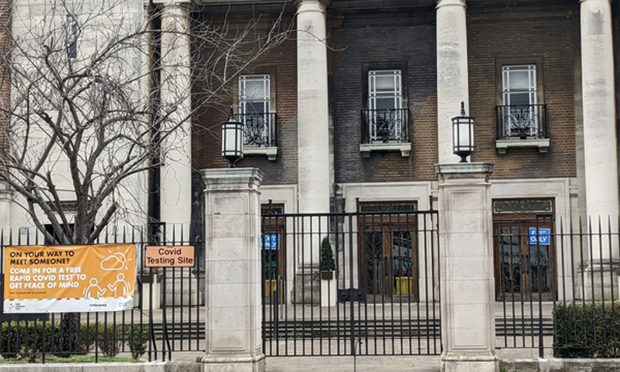Emergency works needed on function room ceiling inside historic Stoke Newington Town Hall

Hackney Council has lodged an application to remove asbestos from the ceiling of a large function room inside Stoke Newington Town Hall after part of the plaster fell away.
The Assembly Hall is closed for maintenance and off-limits to the public, but can usually accommodate 275 standing guests or 163 diners with a dance floor.
The Town Hall “offers decadent 1930s glamour with its outstanding art-deco interiors”, according to Hackney Council’s venues department, which rents it out.
The building is currently home to a rapid testing centre for Covid.
The 1930s Assembly Hall boasts one of Europe’s largest working mirror balls and plays host to weddings, parties and business events. Couples can also tie the knot inside the 83-seat former council chamber.
Work is needed to “provide emergency support to the ceiling of the Assembly Hall in the form of birdcage scaffolding and crash deck”, according to a planning application submitted this month.
The application also asks for listed building consent for the “removal of all elements of ceiling containing asbestos together with necessary temporary asbestos containment works, replacement of removed elements to match, and redecoration”.
The work will cost an estimated £395,000, including £220,000 to repair the ceiling and £100,000 to deal with the asbestos.
A Hackney Council spokeswoman explained : “During the pandemic, whilst the building was empty, part of the ceiling plaster in Stoke Newington Assembly Hall fell and as a precaution there is now scaffolding and safety decking in place whilst we undertake the necessary repairs that are sensitive to the heritage of the building.”
She said the staff and public safery is the council’s number one priority so the the hall is now closed until the repairs are complete.
She added: “Asbestos – which is common in buildings of this age – was not disturbed when the plaster fell and we carried out further air tests to confirm that there is no risk of harm to either the public or staff using any other parts of the building.
“An engineer has conducted a full structural assessment of the entire ceiling and roof space, concluding that the cause of the plaster debris falling is due to the age and deterioration of a number of straps that suspend the ceiling from the underside of the roof structure.
“We’ll now be examining the rest of the straps while doing everything we can to preserve the original ceiling. The roof structure itself however has been determined to be structurally sound. “
Update: this article was amended at 13:38 on 29 September 2021 following a response from the council to requests for comment.
